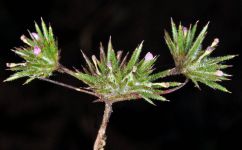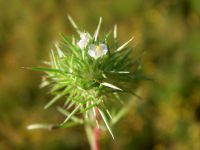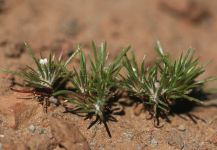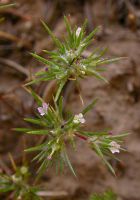Distribution: Occurring east of the Cascades crest in Washington; British Columbia to California, east to Montana and Nevada.
Habitat: Dry, open places from the foothills to mid-elevations in the mountains.
Flowers: June-August
Origin: Native
Growth Duration: Annual
Conservation Status: Not of concern
Pollination: Bees, flies
Low, sticky annual, often broader than high, the primary head only about 5 cm. above the ground.
Leaves few, pinnatifid, with narrow rachis and segments, the segments near the base.
Inflorescence of dense, leafy-bracteate, terminal heads, with naked side branches attached just below the heads also terminating in heads; calyx 6-10 mm. long, with 5 unequal lobes, and with broad translucent intervals between the herbaceous segments; corolla white to pale pink or lavender, shorter than the calyx, the 5 lobes very short; filaments 0.3 mm. long, inserted equally below the sinuses; style 3-parted, but two of the stigmas partly attached to each other; ovary superior.
Capsule often with only 2 cells because of a failure of a partition; seeds 2-4 per carpel.
Publication: Pittonia 1(3): 136. 1887.
-
ssp. divaricata – mountain navarretia
 Occurring east of the Cascades crest in Washington; British Columbia to California, east to Montana and Nevada.
Occurring east of the Cascades crest in Washington; British Columbia to California, east to Montana and Nevada.
PNW Herbaria: Specimen records of Navarretia divaricata in the Consortium of Pacific Northwest Herbaria database
WA Flora Checklist: Navarretia divaricata checklist entry
OregonFlora: Navarretia divaricata information
E-Flora BC: Navarretia divaricata atlas page
CalPhotos: Navarretia divaricata photos
























